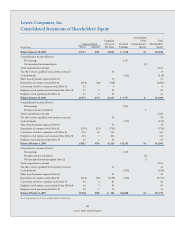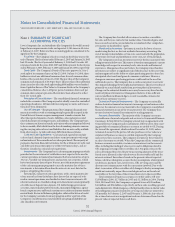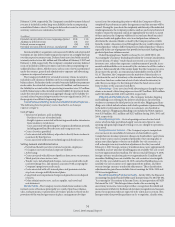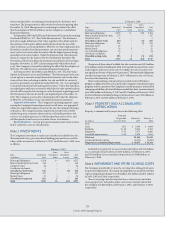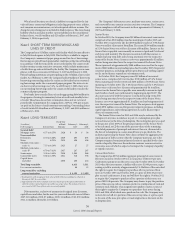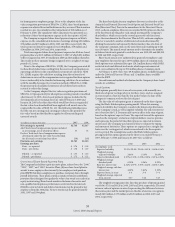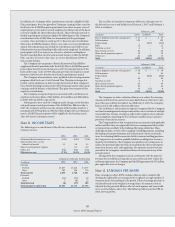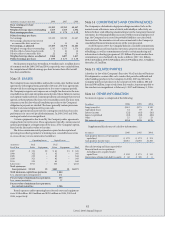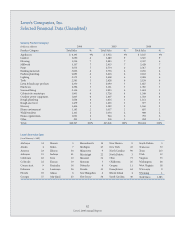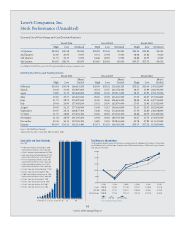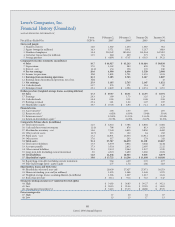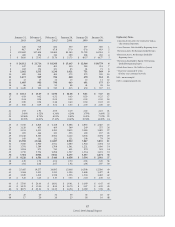Lowe's 2006 Annual Report Download - page 41
Download and view the complete annual report
Please find page 41 of the 2006 Lowe's annual report below. You can navigate through the pages in the report by either clicking on the pages listed below, or by using the keyword search tool below to find specific information within the annual report.
37
Lowe’s 2006 Annual Report
Holders of the senior convertible notes may convert their notes into
34.424 shares of the Company’s common stock only if: the sale price of
the Company’s common stock reaches specied thresholds, or the credit
rating of the notes is below a specied level, or the notes are called for
redemption, or specied corporate transactions representing a change in
control have occurred. e conversion ratio of 34.424 shares per note is
only adjusted based on normal antidilution provisions designed to protect
the value of the conversion option.
e Company’s closing share prices reached the specied threshold
such that the senior convertible notes became convertible at the option
of each holder into shares of common stock during specied quarters of
2006. Holders of an insignicant number of senior convertible notes
exercised their right to convert their notes into shares of the Company’s
common stock during 2006 and 2005. During the fourth quarter of 2006,
the Company’s closing share prices again reached the specied threshold
such that the senior convertible notes are convertible at the option of each
holder into shares of common stock in the rst quarter of 2007.
e Company has $37.7 million aggregate principal of convertible
notes issued in February 2001 at an issue price of $608.41 per note. Interest
will not be paid on the notes prior to maturity in February 2021, at which
time the holders will receive $1,000 per note, representing a yield to maturity
of 2.5%. Holders of the notes had the right to require the Company to
purchase all or a portion of their notes in February 2004, at a price of
$655.49 per note and will have the right in February 2011 to require the
Company to purchase all or a portion of their notes at a price of $780.01
per note. e Company may choose to pay the purchase price of the notes
in cash or common stock, or a combination of cash and common stock.
Holders of an insignificant number of notes exercised their right to
require the Company to purchase their notes during 2004, all of which
were purchased in cash.
Holders of the convertible notes issued in February 2001 may convert
their notes at any time on or before the maturity date, unless the notes
have been previously purchased or redeemed, into 32.896 shares of the
Company’s common stock per note. e conversion ratio of 32.896 shares
per note is only adjusted based on normal antidilution provisions designed
to protect the value of the conversion option. During 2006, holders of
$118 million principal amount, $80 million carrying amount, of the
Company’s convertible notes issued in February 2001 exercised their
right to convert their notes into 3.9 million shares of the Company’s
common stock at the rate of 32.896 shares per note. During 2005, holders
of $839 million principal amount, $565 million carrying amount of the
Company’s convertible notes issued in February 2001 exercised their
right to convert their notes into 27.6 million shares of the Company’s
common stock.
Upon the issuance of each of the series of convertible notes previously
described, the Company evaluated the optionality features embedded in
the notes and concluded that these features do not require bifurcation
from the host contracts and separate accounting as derivative instruments.
Note 7 FINANCIAL INSTRUMENTS
Cash and cash equivalents, accounts receivable, short-term borrowings,
trade accounts payable and accrued liabilities are reected in the nancial
statements at cost, which approximates fair value due to their short-term
nature. Short- and long-term investments classied as available-for-sale
securities, which include restricted balances, are reected in the nancial
statements at fair value. Estimated fair values for long-term debt have been
determined using available market information and appropriate valuation
methodologies. However, considerable judgment is required in interpreting
market data to develop the estimates of fair value. Accordingly, the estimates
presented herein are not necessarily indicative of the amounts that the
Company could realize in a current market exchange. e use of dierent
market assumptions and/or estimation methodologies may have a material
eect on the estimated fair value amounts. e fair value of the Company’s
long-term debt excluding capital leases and other is as follows:
February 2, 2007 February 3, 2006
Carrying Fair Carrying Fair
(In millions) Amount Value Amount Value
Liabilities:
Long-term debt
(excluding capital
leases and other) $4,013 $4,301 $ 3,107 $ 3,578
Interest rates that are currently available to the Company for issuance
of debt with similar terms and remaining maturities are used to estimate
fair value for debt issues that are not quoted on an exchange.
Note 8 SHAREHOLDERS’ EQUITY
Authorized shares of common stock were 5.6 billion ($.50 par) at
February 2, 2007 and February 3, 2006.
e Company has ve million ($5 par) authorized shares of preferred
stock, none of which have been issued. e Board of Directors may issue
the preferred stock (without action by shareholders) in one or more series,
having such voting rights, dividend and liquidation preferences and such
conversion and other rights as may be designated by the Board of Directors
at the time of issuance.
In January 2005, the Board of Directors authorized up to $1 billion in
share repurchases through 2006. In January and August 2006, the Board
of Directors authorized up to an additional $1 billion and $2 billion in
share repurchases through 2007 and 2008, respectively. is program is
implemented through purchases made from time to time either in the
open market or through private transactions. Shares purchased under
the share repurchase program are retired and returned to authorized and
unissued status. During 2005, the Company repurchased 25.0 million shares
at a total cost of $774 million. During 2006, the Company repurchased
56.8 million shares at a total cost of $1.7 billion (of which $160 million
was recorded as a reduction in retained earnings in the third quarter
aer capital in excess of par value was depleted). As of February 2, 2007,
the total remaining authorization under the share repurchase program
was $1.5 billion.
Note 9 ACCOUNTING FOR SHAREBASED
PAYMENT
Eective February 4, 2006, the Company adopted the fair value recognition
provisions of SFAS No. 123(R), “Share-Based Payment,” using the modied-
prospective-transition method. Prior to this, the Company was applying
the fair value recognition provisions of SFAS No. 123, “Accounting for
Stock Based Compensation.” Under the SFAS No. 123(R) transition
method, compensation cost recognized in the year ended February 2, 2007
included: (a) the pro rata compensation cost for all share-based payments
granted prior to, but not yet vested as of February 4, 2006, based on the
grant-date fair value estimated in accordance with the original provisions
of SFAS No. 123, and (b) the pro rata compensation cost for all share-based
payments granted on or subsequent to February 4, 2006, based on the
grant-date fair value estimated in accordance with the provisions of
SFAS No. 123(R). In accordance with the modied-prospective-transition
method of SFAS No. 123(R), results for prior periods have not been restated.
For all grants, the amount of share-based payment expense recognized has
been adjusted for estimated forfeitures of awards for which the requisite
service is not expected to be provided. Estimated forfeiture rates are
developed based on the Company’s analysis of historical forfeiture data





